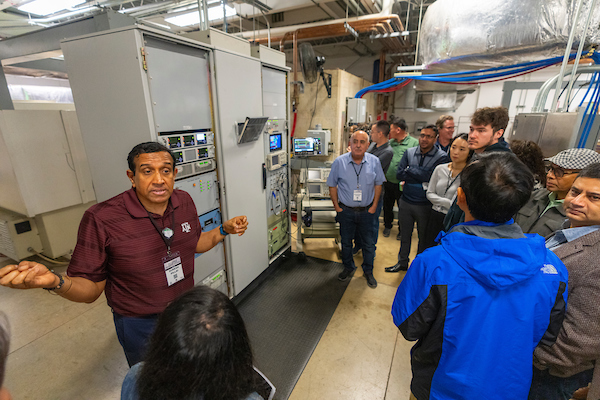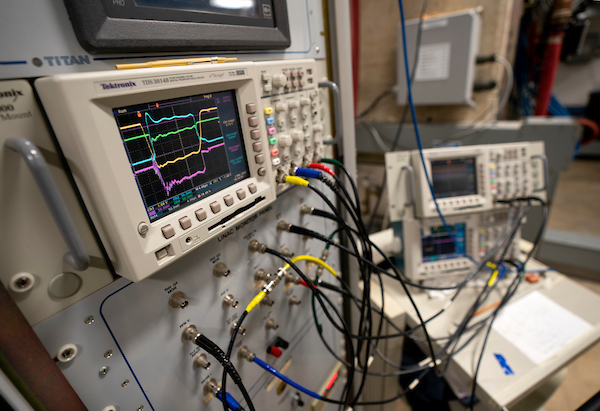AgriLife Research involved in greater electron beam education and adoption
Collaborations instrumental in showing global benefit of eBeam, other technology development and commercialization
Texas A&M AgriLife Research and its partners have expanded their efforts to educate the international community on the benefits of transitioning from technology using radioactive materials to safer alternative technologies such as electron beam.

“Our collaboration with Pacific Northwest National Laboratory and the U.S. Department of Energy has resulted in numerous projects to address the information barrier that the user community faces in considering alternative technologies,” said Suresh Pillai, Ph.D., AgriLife Research professor and associate head of Texas A&M College of Agriculture and Life Sciences Department of Food Science and Technology. Suresh is also director of the National Center for Electron Beam Research at Texas A&M University in College Station.
The National Center for Electron Beam Research, or eBeam Center as it is referred to informally, is the world’s leading academic and research facility for the development and commercialization of electron beam, or eBeam technologies. It also collaborates with U.S. government agencies to reduce the risk of nuclear and radiological terrorism.
In 2014, the eBeam Center was named an International Atomic Energy Agency collaborating center for eBeam use in food, health and environmental applications.
The National Nuclear Security Administration’s Office of Radiological Security, ORS, uses it as a center of excellence for domestic and international partners interested in adopting or transitioning to electron beam technology. ORS also sends their partners to Texas A&M to gain hands-on experience with eBeam technology.
The case for eBeam technology
eBeam technology is a high-speed method of sterilization in which energy from electrons is used to neutralize or kill microorganisms, while protecting material properties, preventing polymer degradation, and maintaining the integrity of sterile seals.
A primary objective of eBeam research is to reduce the commercial use of high-activity radioactive sources used for sterilization, including cobalt-60 and cesium-137.
“While technologies using radioactive materials have fed and saved millions if not billions of lives by their use in medicine and agriculture, they can pose a serious radiological security risk,” Pillai said. “We want to help reduce the global reliance on high-activity radioactive sources by promoting adoption and development of alternative technologies like eBeam and X-ray technologies.”
He said the collaboration between ORS and the eBeam Center directly enhances U.S. and global security by preventing high-activity radioactive materials from being used in acts of terrorism.
Overcoming obstacles through research, education
Pillai said even with the existence and recent advancements of eBeam and other technologies that do not use radioactive materials, many people globally simply do not have enough information to consider converting to alternative technology.
One impediment to adopting eBeam technology is concern over electrical grid reliability. To help address and alleviate the power resiliency issue, the center and Pacific Northwest National Laboratory are conducting concurrent electrical reliability studies in about a dozen countries. Additionally, they have set up advanced electrical sensors in eBeam facilities in the U.S. and Mexico.

“Power resiliency is essential for irradiation facilities, such as those that use around-the-clock eBeam facilities for food and medical device sterilization,” said Jennifer Elster, Ph.D., senior research scientist and program manager at Pacific Northwest National Laboratory. “Power surges or fluctuations can potentially damage crucial electronic equipment or cause components to operate outside normal values, leading to component failure.”
“This will help the team understand the electrical power requirements throughout the entire operating cycle,” Elster said.
The eBeam Center is a key partner in ORS educational outreach activities that include discussions with international partners and presentations at workshops on the use of eBeam technology.
ORS has funded collaborative projects with AgriLife Research to share eBeam-technology related data and information globally.
“Information provided by our eBeam Center, the collaboration with Pacific Northwest National Laboratory, and through the National Nuclear Security Administration’s global outreach will help ensure alternative eBeam technologies will increasingly replace cobalt and cesium devices,” Pillai said.


